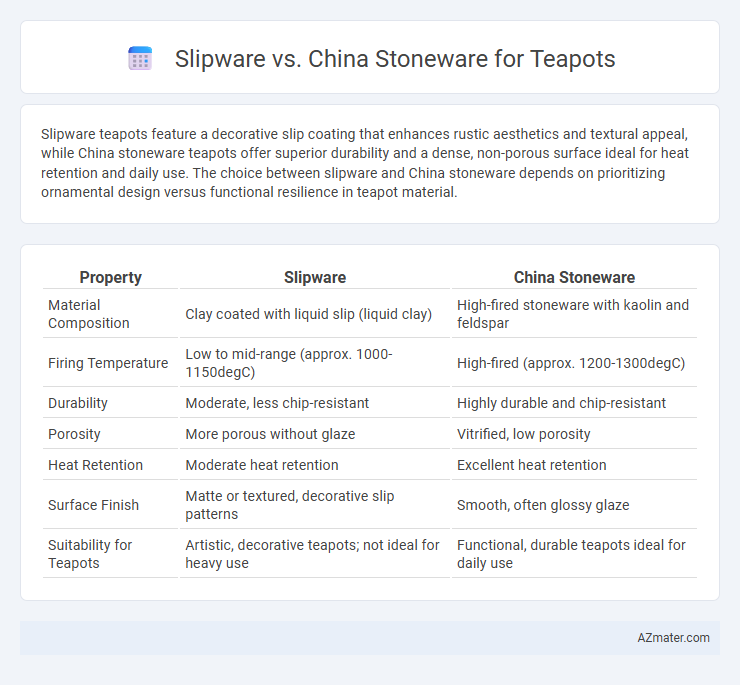Slipware teapots feature a decorative slip coating that enhances rustic aesthetics and textural appeal, while China stoneware teapots offer superior durability and a dense, non-porous surface ideal for heat retention and daily use. The choice between slipware and China stoneware depends on prioritizing ornamental design versus functional resilience in teapot material.
Table of Comparison
| Property | Slipware | China Stoneware |
|---|---|---|
| Material Composition | Clay coated with liquid slip (liquid clay) | High-fired stoneware with kaolin and feldspar |
| Firing Temperature | Low to mid-range (approx. 1000-1150degC) | High-fired (approx. 1200-1300degC) |
| Durability | Moderate, less chip-resistant | Highly durable and chip-resistant |
| Porosity | More porous without glaze | Vitrified, low porosity |
| Heat Retention | Moderate heat retention | Excellent heat retention |
| Surface Finish | Matte or textured, decorative slip patterns | Smooth, often glossy glaze |
| Suitability for Teapots | Artistic, decorative teapots; not ideal for heavy use | Functional, durable teapots ideal for daily use |
Introduction to Slipware and China Stoneware
Slipware teapots are crafted using a clay body coated with liquid clay slip, often decorated with intricate patterns and earthy tones, emphasizing a traditional and artisanal aesthetic. China stoneware teapots, made from high-fired stoneware clay, feature a dense, vitrified body that offers superior durability and a smooth, refined finish ideal for everyday use. Both materials balance functionality and artistry, with slipware highlighting decorative appeal and china stoneware prioritizing strength and heat retention.
Historical Background of Teapot Materials
Slipware teapots, originating in medieval England, utilized a technique where liquid clay was applied for decorative and functional qualities, showcasing a rustic and artisanal appeal. China stoneware, developed in the 18th century, combined the durability of stoneware with the refined aesthetics of porcelain, making it a popular choice for high-quality teapots in both Europe and Asia. The historical evolution of teapot materials reflects regional preferences and technological advances, with slipware emphasizing handcrafted tradition and China stoneware highlighting innovation and resilience.
Craftsmanship Techniques: Slipware vs China Stoneware
Slipware teapots are crafted using a technique where liquid clay slip is applied to create decorative patterns and textures, emphasizing hand-painted or dipped designs that result in a rustic, tactile finish. China stoneware teapots, by contrast, are known for their refined wheel-thrown or molded forms, glazed surfaces, and high-fired durability, showcasing precise craftsmanship and smooth, elegant finishes. The slipware technique prioritizes artistic expression through organic texture, while china stoneware highlights structural refinement and luminosity in teapot production.
Aesthetic Differences: Glaze, Color, and Texture
Slipware teapots exhibit a tactile, handcrafted aesthetic with vibrant, earthy glazes achieved through flowing slip decoration, creating dynamic patterns and slightly textured surfaces. China stoneware teapots feature a smooth, glossy finish with refined, consistent colors ranging from classic whites and soft pastels to muted earth tones, emphasizing sleek and uniform textures. The contrast between slipware's organic, rustic charm and china stoneware's polished, elegant appearance defines their distinct visual appeal in teapot artistry.
Durability and Heat Retention Comparison
Slipware teapots, crafted from earthenware with a slip coating, generally offer moderate durability but are more prone to chipping and cracking under thermal stress compared to China stoneware. China stoneware teapots, made from dense, vitrified clay, provide superior heat retention due to their higher thermal mass and enhanced resistance to thermal shock. This makes China stoneware a preferred choice for long-lasting durability and efficient heat retention in teapot usage.
Porosity and Flavor Impact on Tea Brewing
Slipware teapots typically exhibit higher porosity compared to China stoneware, allowing subtle absorption of tea flavors that can enhance taste complexity over time. China stoneware features a denser and less porous structure, which minimizes flavor retention and ensures pure, clean brews ideal for delicate teas. The choice between slipware and China stoneware directly influences the interaction between teapot material and tea flavor development during brewing.
Maintenance and Cleaning Considerations
Slipware teapots require gentle hand washing with mild detergent to preserve their intricate glaze and porous surface, which can absorb stains and odors if not properly maintained. China stoneware teapots offer greater durability and resistance to chips and scratches, allowing for easier cleaning even with more robust scrubbing or dishwasher use, making them ideal for everyday use. Regular descaling and thorough drying are essential for both materials to prevent buildup and maintain optimal performance over time.
Price and Availability in the Market
Slipware teapots are typically more affordable due to their handcrafted nature and widespread availability in artisan markets and online platforms, making them accessible to budget-conscious buyers. China stoneware teapots, known for their durability and refined finish, often come at a higher price point and are primarily available through specialty retailers and higher-end kitchenware stores. The market availability of slipware is broader, while china stoneware is limited to niche outlets, impacting both price sensitivity and purchasing options.
Collectors’ Perspectives: Value and Rarity
Collectors often value slipware teapots for their unique hand-crafted designs and historical significance, which contribute to their rarity and higher market demand. China stoneware teapots appeal due to their durability, refined glaze, and often striking artistic patterns, making them prized items in specialized collections. The scarcity of well-preserved examples in either category significantly influences their auction prices and desirability among collectors.
Choosing the Right Teapot: Slipware or China Stoneware?
Slipware teapots, known for their rustic appeal and hand-decorated glaze patterns, offer excellent heat retention and a unique aesthetic that enhances the tea brewing experience. China stoneware teapots provide durability with a smooth finish, high-temperature resistance, and non-porous surfaces that prevent flavor absorption, ensuring pure taste with every brew. Choosing between slipware and china stoneware depends on preference for artisanal craftsmanship versus practicality and durability in everyday use.

Infographic: Slipware vs China Stoneware for Teapot
 azmater.com
azmater.com